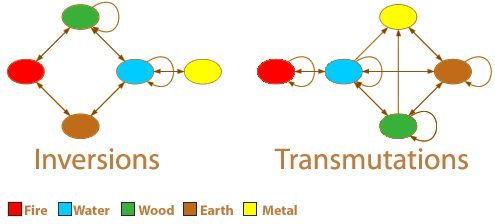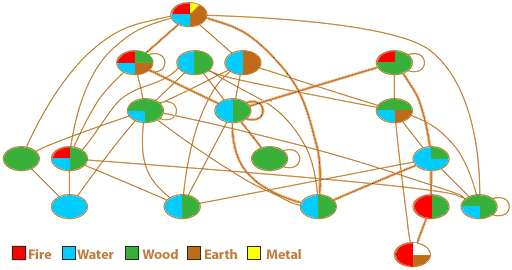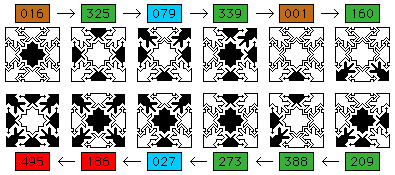
In addition to season and form, I have assigned each pattern in the Starmaze an element. The assignment is based on the how quickly the pattern can change into its inverse. Because of parity, the shortest path from a room to its inverse always requires an odd number of steps.
The fastest patterns require five steps. Others require seven or nine steps. The classic solution path from the starting pattern is an example of an eleven-step inversion path. And there are four even slower rooms in the maze that require thirteen steps.
So I needed a total of five elements. For this purpose, I decided on the five classic Chinese elements: fire, water, wood, earth, and metal. In Chinese thought, these elements represent not substances, but different processes or forms of change.
Fire is pure, unconstrained motion. Water moves in a seamless way, but with some weight, like the "fluid" movement of a tiger creeping through a jungle. The third element is sometimes translated as "wind" instead of "wood"; it is best understood as the wind blowing through trees, an organic interplay of force and resistance which varies from the slow turn of a sunflower on a still day to the gentle rustling of leaves in a breeze to the solemn bow of a great tree in a storm. Earth is a firmness which rarely but inevitably yields to internal pressures, crumbling or sliding or even shaking. Metal is the opposite of fire: the rigid refusal to bend.
I arranged my patterns, then, based on the speed and fluidity with which they can invert themselves. A flickering fire pattern can reach its inverse in 5 steps, a flowing water pattern in 7 steps, a bending wood pattern in 9 steps, a rarely quaking earth pattern in 11 steps, and a solid metal pattern in 13 steps.
Because there is no escape from pattern 0, it cannot be assigned any of these five elements. I have therefor assigned it the element of emptiness.
There are a total of 32 fire patterns, 192 water patterns, 238 wood patterns, 45 earth patterns, and 4 metal patterns (gold, silver, bronze, and iron). When plotted on the starmap they look like this:

A pattern's element is determined by its inversion speed. Inversion speed, in turn, is effected by the number of open yin cells. Basically, the more open yin cells, the less time it takes to invert a pattern. The reason for this is that, geometrically, inverse patterns always differ by the same five binary coordinates: the center and the four yin (corners).
This means that in order to invert a starmaze pattern, you have to flip the center and each of the corners an odd number of times. If all the corners are already open, you only have to flip them once. If some are closed, you may have to flip some yang cells to open them and then flip the same yang cells again to correct the imbalance.
As a result, you can guess what element a pattern is by simply counting its open yin cells:

- Fire patterns consist of the 32 variations in which all four yin (corner) cells are on. To invert a fire pattern, simply select each of the four yin cells plus the center in any order (the center flips with each move).
- Water patterns consist of all the patterns with 3 open yin cells and one third of the patterns with 2 open yin cells.
- Wood patterns consist of the remaining two thirds of the 2-yin patterns, three fourths of the 1-yin patterns, and 14 of the 32 0-yin patterns.
- Earth patterns consist of all the 1-yin patterns with one or more of its three neighboring cells open, and all the 0-yin patterns with clusters of one or more of the same three cells (neighboring yang plus center).
- Metal patterns consist of the four patterns with only a single yin cell open. Because there is only one open cell, the first move is forced and the yin cell is flipped prematurely. This means that the starting yin cell must be flipped two more times to complete the inversion, resulting in the longest room-to-room paths in the maze.
Similarly, each element can transmute into one or more other elements. Every movement from room to room within the starmaze can represent a transmutation of elements. There are some limitations on how the elements can change. The possibilities for both inversion and transmutation are shown in the following diagram:

When I first began investigating starmaze elements, I thought that all inversion paths, including the many different solution paths, would all involve traveling to a fire room, turning around in five steps, and then backing out the way you came in. But because the possibilities of change between elements is so varied and complex, this turns out not to be the case.
This becomes clear when you correlate elements with forms. Each of the 20 forms includes patterns of from one to four different elements. When element colors are mapped to the form transformation chart, it becomes clear that there are many different ways of traveling from a pattern to its inverse:

The starting pattern is in the earth quadrant of form 20 in the lower right corner; the bold lines are solution paths. Half of the 1920 solution paths begin by traveling to a fire pattern of form 5 in the upper right corner. But many others avoid fire altogether until the end. Here is one example:
